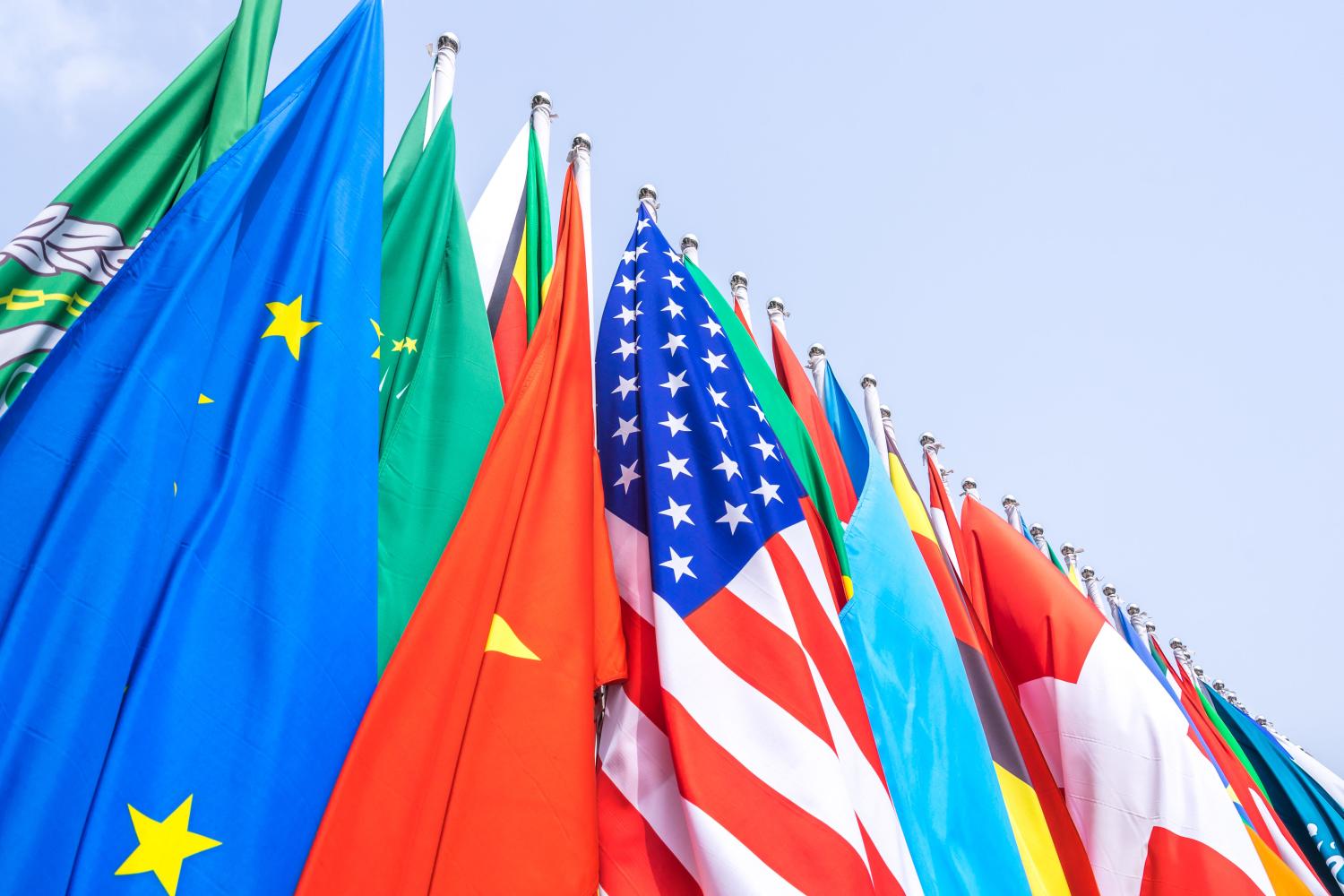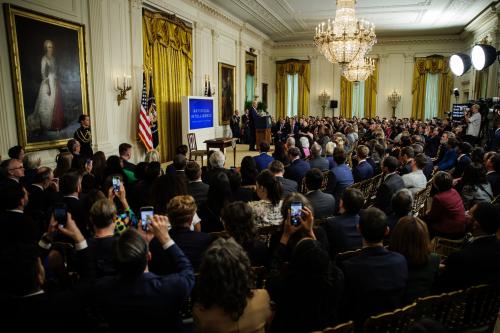This brief introduces the Governance section of the Brookings Blueprints for American Renewal & Prosperity project.
 The Biden administration is less than one month old, but the challenges facing the United States—from getting ahead of the COVID-19 crisis and dealing with its economic and social costs, addressing climate change, and dealing with China—are already front and center of the administration’s work. In these Governance papers for Brookings’s Blueprints for American Renewal & Prosperity, Brookings scholars offer a variety of specific recommendations to the administration on ways to strengthen U.S. and global governance that are in many cases directly tied to the challenges and opportunities facing the administration. Many of these recommendations also give content to the administration’s goal of building back better domestically as a necessary basis for effective global leadership. This is not merely a matter of sequencing—working on domestic issues before turning to global challenges—but it also reflects the reality that where the U.S. makes progress domestically, it has direct effects globally, and vice versa—that global developments can reinforce or hinder domestic priorities. From this perspective, three key themes emerge:
The Biden administration is less than one month old, but the challenges facing the United States—from getting ahead of the COVID-19 crisis and dealing with its economic and social costs, addressing climate change, and dealing with China—are already front and center of the administration’s work. In these Governance papers for Brookings’s Blueprints for American Renewal & Prosperity, Brookings scholars offer a variety of specific recommendations to the administration on ways to strengthen U.S. and global governance that are in many cases directly tied to the challenges and opportunities facing the administration. Many of these recommendations also give content to the administration’s goal of building back better domestically as a necessary basis for effective global leadership. This is not merely a matter of sequencing—working on domestic issues before turning to global challenges—but it also reflects the reality that where the U.S. makes progress domestically, it has direct effects globally, and vice versa—that global developments can reinforce or hinder domestic priorities. From this perspective, three key themes emerge:
- The U.S. government needs to work more effectively across traditional boundaries, whether that be between the federal and the state/local levels of government or between what is domestic and what is international. For instance, Anthony F. Pipa and Max Bouchet outline how reinvigorated U.S. diplomacy requires more systemic engagement with state and local leaders who themselves are building global networks as they seek to deal with challenges that are both domestic and global, such as the pandemic and climate change. Landry Signé and Stephen Almond address the regulatory challenges from digital technology, highlighting the crosscutting nature of the many technologies that will require government to work horizontally and with industry to anticipate and design more agile approaches that protect human health and safety and support innovation.
- Addressing global challenges requires an approach to governance that is multistakeholder—where government, the private sector, and civil society work together to develop policy and deliver results. Emily Gustafsson-Wright builds on her extensive work on impact bonds, and, along with Sarah Osborne, outlines the steps the U.S. can take to use impact bonds to crowd in private sector capital to address pressing social and environmental challenges, both in the U.S. and globally. Cameron Kerry and I outline why U.S. leadership on artificial intelligence (AI) is needed to build trustworthy AI that reflects liberal democratic values and extends the economic and social opportunities of AI broadly. Achieving this will require working with allies and building a multistakeholder approach to AI governance.
- The scope of the challenge requires the administration to reorientate its approach in some key areas of governance. George Ingram makes clear the need to elevate the importance of development in the administration’s approach to global challenges, but doing do will require significant USAID reform, including developing a USAID culture that can execute on a U.S. development strategy.
These Blueprints also reflect two underlying trends—that U.S. leadership on addressing global governance challenges is essential, and that there no quick fixes. This is particularly true after the Trump administration, where rebuilding domestic capacity and overseas and regaining international trust in U.S. leadership will take patience and sustained attention.
Emily Gustafsson-Wright and Sarah Osborne highlight how impact bonds can help governments overcome budgetary constraints to address urgent social and environmental challenges, many of which have been made particularly acute as a result of COVID-19. In an impact bond, private investors provide upfront financing that the government or other funder only repay if the social service program is successful. As detailed in Emily’s 2015 seminal report on impact bonds, these tools: ensure that limited available funding is directed at programs that produce results in the form of measurable outcomes; provide a mechanism to crowd in much needed private capital to deliver a social and financial return; and transfer the risk of social programs from governments to investors, thereby helping target recovery efforts. While impact bonds are being used in the U.S. and elsewhere, barriers are limiting their uptake including the need for government and service providers to shift their mindset away from the status quo and paying for services that don’t deliver outcomes, to a focus on outcomes. To make this shift in approach a reality will require increased capacity, the ability to understand the importance of data for measuring outcomes, and to engage in adaptive management—using real-time evidence to tailor services to the needs of beneficiaries so that outcomes are achieved. Legislation may also be needed to reform existing incentives against using impact bonds, such as the inability to commit funds into the future, limits on donors paying returns to private investors, and tax policies that discourage investing in philanthropic ventures that lend a return. Finally, Emily stresses that for impact bonds to have an impact will require building economies of scale in raising and managing investment capital for impact bond projects. Here, government also has a role, such as developing dedicated funds that pay for outcomes in impact bonds.
Anthony F. Pipa and Max Bouchet connect the administration’s goals of building back better and reinvigorating trust in U.S. global leadership with developing comprehensive and systemic engagement by the State Department with government at the state and city levels. As Tony and Max write, “The world has lost confidence in the ability of and effectiveness of the U.S. federal government to address global problems … and the U.S. has far to go to rebuild its credibility amongst the community of nations.” Counterintuitively, thicker engagement by the State Department with U.S. states and cities presents an important opportunity for rebuilding U.S. credibility at the global level, extending U.S. soft power, and reinvigorating U.S. diplomacy. It is at the local level where global challenges from climate change to the pandemic are most directly felt. In seeking to address these challenges, governors and mayors are increasingly engaged in international diplomacy, forming connections with other mayors—such as the convening by Los Angeles Mayor Eric Garcetti of 45 mayors from around the world to share experiences fighting COVID-19, or the decision by over 450 U.S. cities to uphold the Paris climate change accord following Trump’s withdrawal. State and city officials have important sources of expertise and, through their engagement with the world, can help other countries understand the U.S., and demonstrate effective U.S. leadership. Yet, there is currently no mechanism for the State Department to leverage these resources for broader diplomatic strategy. The State Department has six regional offices in major U.S. cities focused on consulate services and the Department of Commerce engages across the U.S. to support overseas trade activities. This, however, does not begin to capture the opportunities of a more formalized approach that connects U.S. diplomacy with local activities.
Tony and Max propose an office in the State Department headed by a senior official and appropriately staffed, as well as a fellowship program that places foreign service officers for tours of duty in U.S. cities and state governments. Strengthening these links would produce a number of benefits, including strengthening the capacity of states and cities to engage globally, and building relationships between State Department diplomats and local citizens, providing a potentially important channel for linking the administration’s goal of making U.S. diplomacy relevant to the needs and priorities of the working- and middle-class families. Second, cities and states have important insights, experience, and global networks that the State Department should draw on. Finally, State Department officials could strengthen the ability of cities and states to manage the geopolitical and security sensitivities that will inevitably arise as they build their own international partnership.
Landry Signé and Stephen Almond address the importance of regulatory reform for enabling technological innovation that can support economic growth and address pressing social and environmental needs. Landry and Stephen outline how the cross-cutting nature of digital technologies (think of the impact of Uber on transport or Airbnb on accommodation) and the pace of technological change have rendered traditional processes for developing regulation too slow and too siloed to be effective. This includes the need to reform outdated regulation that can stifle innovation. Landry and Stephen emphasize the need for regulatory foresight, which requires regulators to engage regularly with business and civil society to identify the risks and opportunities of technology as it is being developed. Such a forward-looking approach could allow regulators to be better prepared to regulate or to use nonregulatory measures such as voluntary standards. This also reflects one of the broader themes in this Blueprint series—of the need for regulators, business, and other stakeholders to work together more effectively. To ensure that regulation is not quickly superseded by new developments, regulation needs to also be outcomes-focused. Here, sandboxes and other forms of regulatory forbearance have provided space for experimentation before being subject to the full suite of regulation. Yet, these approaches are not without risks and care is needed to ensure that these experiments don’t confer an unfair competitive edge on emerging technologies. Translating a more innovative domestic regulatory approach into international cooperation, Landry and Stephen point to the importance of interoperability—whereby different regulations build bridges that prevent regulatory differences translating into barriers to trade.
George Ingram focuses on the need for the U.S. Agency for International Development to be able to play a role in shaping U.S. international development strategy, policy, and its implementation. This matters if the administration is going to address the key challenges of COVID-19 and climate change. In addition, what role USAID can play in responding to how China uses development to promote its strategic interests needs much work, moving from an us-and-them approach under the Trump administration to what Ingram calls a policy of “step up, not back,” which provides space for USAID to work with China on shared development goals such as climate change and humanitarian assistance while also providing other countries with alternatives to relying on Chinese assistance. Ingram makes clear that to achieve these goals is less a matter of restoring USAID to some bygone halcyon days of influence, and instead recognizes that the U.S. has never had a comprehensive strategy for development, which would require envisioning a role for USAID, including placing USAID at the center of U.S. development policy and implementation, with full control over its budget, and a more agile hiring process that reflects needed skill sets and provides various career paths.
The early nomination of Ambassador Samantha Power as the administrator of USAID is a good first step and including the position on the National Security Council is an early signal that the Biden administration intends to take development seriously. However, more is needed. In this Blueprint, Ingram lays out key next steps including legislation requiring each administration in its first year to issue a comprehensive U.S. Global Development Strategy, assessing what policies are needed for the priorities of COVID-19 and climate change, giving USAID full budget authority, and improving USAID career paths and staffing levels.
Joshua Meltzer and Cameron Kerry focus on the need for the Biden administration to lead on building international cooperation on AI. AI is a potentially transformative technology that will have broad social, economic, national security, and geopolitical implications for the U.S. and the world. COVID-19 has accelerated the use of AI across manufacturing, transportation, health, education, and other sectors. U.S. leadership on building international cooperation on AI is needed for two key reasons. The first is to work better with other democracies that are developing their own AI policies to build a common approach to trustworthy AI, to maximize synergies in areas such as AI R&D, and to avoid divergent AI regulation becoming barriers to the use of AI. The opportunities from AI also need to be extended globally. The second challenge is concerning China. While the U.S. is the leading AI power, China is rapidly catching up and may lead in some areas. In so doing, China is erecting barriers to the free and open development of AI, appropriating benefits for its national champions, and applying AI as a geopolitical lever. The Chinese government is also using AI in ways at odds with liberal democratic norms, including strengthened state surveillance and control over society.
As outlined in the Blueprint, there are a range of forums where international cooperation on AI is already being pursued, including the G-7 and its offshoot the Global Partnership on AI, the G-20, and OECD, as well as international standards bodies such as ISO, IEC, and IEEE. Cameron and I recommend that the U.S. should engage fully in these bodies. However, none of these fora include the right mix of leaders. The U.S. should therefore also work with ad hoc coalitions of like-minded countries and consider convening an annual leaders-level meeting around international cooperation on technology issues including AI. We suggest that initial members would include the U.S., Canada, U.K., EU, Germany, France, Japan, Australia, Singapore, and Chile. Working through these various groups, the administration’s focus for international cooperation on AI should be in the following areas: 1) putting international cooperation into practice through AI projects that can address pressing global challenges such as health and climate change; 2) building cooperation on AI with other democracies with a focus, especially on the EU as the leading U.S. trading partner and a fulcrum of policymaking on AI and other technology issues; 3) focusing in these channels on a coordinated approach to AI ethics, regulation, international standards, and development; 4) expanding the use of trade agreements to develop rules and norms around AI; and 5) working with allies to develop an approach to AI that serves as a counterpoint to China’s AI policies and use of AI, while also finding ways not to shut the door completely on working with China, including on AI R&D.



